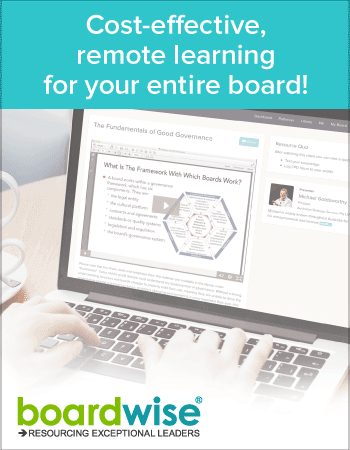Company Secretary Playbook: Which Executives should attend Board Meetings?
-
governance
Governance Company Secretary Playbook: Which Executives should attend Board Meetings?
Board meetings are a critical governance mechanism for non profits. The board is responsible for providing strategic guidance, oversight, and accountability for the CEO and executive team. Well-run board meetings are essential for the board to effectively carry out these duties.
A key consideration when planning nonprofit board meetings is determining which executive staff members beyond the chief executive officer (CEO) should attend a meeting.
While the CEO is often present as the bridge between governance and management, should other executives like the chief financial officer (CFO), chief operating officer (COO), chief information officer (CIO) and department heads participate as well? Or should board meetings be limited to directors and the CEO? How can directors have discussions without the CEO?
There are benefits and drawbacks to having a wider executive presence at board meetings that non profits should weigh when making this decision. By considering these tradeoffs and following best practices around meeting structure and communication norms, boards can optimise their meetings to allow for transparency and accountability while maintaining a culture of trust.
The Governance Role of the Nonprofit Board
To understand the implications of executive staff presence at board meetings, it’s helpful to first review the core governance responsibilities of the nonprofit board.
While day-to-day operations are led by the CEO, the primary role of the board is stewardship of the organisation as a whole. At a high level the boards key roles include:
Providing Strategic Guidance - The board reviews and approves the organisation’s strategic plan to ensure alignment with the nonprofit’s mission and vision. Directors provide strategic insights to the CEO but allow management discretion over tactical implementation.
Financial Oversight - The board is responsible for oversight of the organisation’s financial health and use of resources. This includes reviewing and approving the annual budget and audited financial statements.
Accountability for the CEO - One of the board’s most important jobs is hiring, evaluating, and supporting the CEO. The board is ultimately responsible for CEO succession planning and dismissal if necessary.
Compliance Monitoring - The board ensures that the non profit complies with all applicable laws and regulations. This reduces organisational risk.
Capacity Building - Directors can assist the organisation to access to skills, expertise, and networks that build organisational capabilities.
Fulfilling these responsibilities requires both transparent communication with the CEO and opportunities for independent, candid board discussions. Adding in executive staff at board meetings can both facilitate and hinder the board’s governance role.
Benefits of Executive Attendance at Board Meetings
There are many potential benefits to having key executives like the CFO, COO, and program heads attend board meetings along with the CEO:
Complete Information Flow - Additional executives can provide fuller operational updates in their areas of expertise, allowing the board to see a more complete picture of the organisation. The CEO alone can’t be expected to have granular knowledge of all areas (this is particularly relevant as organisations get larger and more complex).
Balanced Perspectives - Multiple points of view from different staff enhance objectivity compared to relying solely on the CEO’s interpretation of organisational performance and culture.
Credibility of Reporting - Having executives present directly to the board boosts the credibility and validity of reporting. It demonstrates results are not just taken at the CEO’s word.
Deeper Engagement - Direct engagement between the board and management facilitates better relationships and allows directors to get to know potential successor candidates.
Exposure for Emerging Leaders - Presenting to the board gives high-potential staff valuable visibility and developmental experience interacting with governance leadership.
Succession Planning - Familiarity between the board and executives eases leadership transitions. Which is especially important as internal promotions have a higher success rate than external hires.
Workload Sharing - Additional presenters alleviate demands on the CEO to be responsible for covering all topics. This allows greater energy to be focused on the most critical issues.
Talent Showcasing - Seeing executives in action allows the board to better evaluate organisational strengths and identify gaps that may need supplemental capabilities.
Morale Boost - Being selected to present to the board signals trust in the executive’s expertise and can improve motivation. It demonstrates their work is valued by leadership.
Thoughtfully expanding executive participation in board meetings provides benefits around information flow, leadership development, and succession planning.
However, there are also risks boards should be aware of and mitigate through careful meeting design.

Pitfalls of Executive Presence Pitfalls of Executive Presence
While limited executive participation is positive, having too many staff members or the full executive team present at every board meeting can be counterproductive:
Overly Large Meetings - More attendees inevitably lengthen meeting times and reduce productivity. Every additional participant has the potential to exponentially multiply questions, tangents, and opinions.
Excessive Operational Details - Too many executives risks turning board meetings into a forum for getting into the weeds of day-to-day operations rather than governance. The board can lose strategic focus.
Diffused Accountability - A large staff presence can diffuse the CEO’s accountability to the board. Responsibility can become clouded by the sheer number of other voices in the room.
Spotlight Grabbing - Well-meaning but overly enthusiastic executives may inadvertently divert attention reserved for other critical strategic matters.
Grandstanding - Staff members seeking to raise their internal profile may be tempted to grandstand or present unrealistic proposals rather than give measured feedback.
Diluted Independent Discussions - The more operational staff added, the further the meeting gets away from being a forum for independent director discussion outside management influence.
Stifled Conversations - Directors can become reluctant to have candid conversations about organisational performance or other issues if executives are present in the room.
Undermined Authority - Strong or sensitive board feedback in front of staff about performance can undermine their authority within the management team.
Non profit boards should be intentional about limiting executive presence to avoid overextension of staff roles into governance territory.
Best Practices for Productive Board Meetings with Executives Attending
Structuring the board meeting agenda wisely and setting norms around executive participation can allow non profits to maximise benefits while minimising potential pitfalls. Consider the following:
Be Selective About Who Attends - The CEO should attend all meetings, but be discriminating with other executives. Include key department leaders on a rotating basis, those presenting, and named successors only. Keep the group small. Use a board calendar to plan this in advance.
Vary the Mix Meeting to Meeting - Don’t overwhelm every meeting with the full executive team plus directors. Have targeted executives attend quarterly or semi-annually to present on strategically aligned priorities.
Set Clear Expectations on Roles - Establish guidelines for executives so that they understand that management is present to provide insights but governance is the board’s domain. Discourage grandstanding.
Limit Meeting Length - Keep participant numbers contained to avoid meetings extending unnecessarily. Stick to timed agendas.
Hold In-Camera Sessions - Schedule board-only (in-camera sessions) discussion time without the CEO or executive staff both before and after the full meeting to allow open dialogue.
Sequence the Agenda - Cluster executive presentations together during a section of the overall meeting. Bookend with board-only segments.
Alternate Presenters - Split key presentations across multiple meetings rather than packing everything into one. This balances workloads and perspectives.
Utilise Committee Meetings - Have executives meet with and report to relevant board committees first before bringing topics to the full board meeting.
Be Explicit on Action Owners - Document clear owners for follow up on all decisions and action items to avoid diffusion of accountability.
Assess Meeting Dynamics Annually - Regularly solicit director feedback on the board meeting process. Identify any needed changes.
Monitor Cultural Impact - Stay alert to negative team dynamics like distrust emerging from how board meetings are conducted.
Limit Executives In-Meeting Time - Consider that executives invited to attend should only be present for their allotted presentation and question time and then leave the meeting. Obviously in some circumstance the board may request the stay longer but they should not be there just for the sake of being there.
With purposeful agenda design choices and norms, staff can meaningfully augment board meetings without detracting from the board’s essential governance role.
Structuring the Board Meeting Agenda
Well-structured meeting agendas with purposeful sequencing and allocation of time to different discussions are vital to optimising information flow while preserving board independence.
Here are some thoughts on a potential agenda template for a board meeting that brings in members of the executive team.
# Item Presenter Time #1 Welcome to Country
Or a local traditional or indigenous greeting or custom relevant to your organisation5 min #2 Attendance 5 min #3 Opening Board In-Camera Session
Start with 15-30 minutes of board-only discussion to get aligned on priorities and raise any sensitive issues before staff arrive.Board Chair 15 min #4 CEO Operational Briefing
The CEO shares a condensed overview of organisational milestones, challenges, and top priorities to frame the board’s advisory work.CEO 15 - 30 min #5 Executive Presentations
Select executives present on key initiatives or high risk/high opportunity topics like the budget, fundraising campaigns, or expansion projects.#5.1 Executive Presentation 1 CFO 15 min #5.2 Executive Presentation 2 Head of Marketing 15 min #6 Break 5 min #7 Sub Committee Updates
Committee chairs report out on work completed since the last board meeting, escalating any major recommendations.Committee Chairs 15 min #8 Monitoring Reports
The CEO and staff present dashboard updates on metrics tied to the strategic plan like financials, programs, and people.CEO 15 min #9 Strategy Discussion
The board and CEO engage in generative discussion on pressing strategic issues and priorities requiring board input.Board Chair 15 min #10 In-Camera Session
Staff depart to allow the board candid discussion and calibration on the CEO’s performance, organisational health, and any sensitive matters.45 min #11 Meeting Recap
The CEO returns for quick recap of conclusions reached and assignments moving forward.CEO 10 min #12 Break 5 min #13 Closing Session
Final board-only time to agree on near-term action steps and continue candid conversations as needed.Board Chair 10 min
Thoughtful agenda architecture enables efficient information sharing while preserving adequate board-only work time free of staff influence.
Setting Participation Norms and Communication Standards
In addition to tightly orchestrating the flow of topics during board meetings, establishing clear norms of behavior helps avoid unproductive dynamics between directors and attending staff:
-
Present concisely. Executives should aim for high-level presentations focused on key insights, risks, dependencies, and recommended actions. Avoid excessive detail.
-
Embrace questions. Managers should welcome clarifying questions from the board after presentations. This builds understanding. But defer any opinionated debate to maintain strategic focus.
-
Mind tone. Executives should take care to avoid seeming defensive in front of the board. Mild tension is normal, but the overall tone should remain professional.
-
Stay in lane. Executives are there to share knowledge and operational context that informs governance. Strategic direction remains the board’s role. Managers shouldn’t overly insert themselves into strategy decisions.
-
No end runs. During healthy debate, executives should not try to lobby individual directors before or after the meeting to influence decisions outside of the full discussion.
-
Limit grandstanding. Individual managers hoping to raise their internal profile shouldn’t overly chase the spotlight or push personal agendas. Keep presentations balanced and objective.
-
Measure transparency. Executives should share setbacks just as readily as progress to build trust through candid communication. Withholding negative information damages credibility over time.
-
Discuss, don’t interrupt. Managers should avoid interrupting or talking over board members during their discussion time. Tactfully provide additional context only when asked.
-
Read the room. Executives should be alert to body language and cues indicating sensitive board dialogue. Refrain from interjecting opinions at tense moments.
Setting these participation norms upfront helps establish mutual respect between the board and staff during meetings.
Handling Sensitive Conversations
One area requiring particular care is how to have candid board conversations about the CEO’s performance with or without the management team present.
Discussing the CEO’s strengths, development areas, and even missteps serves an important accountability function. However, mishandling this communication risks undermining leaders in front of their teams. Strategic pairing of agenda items and guests minimizes this risk.
For routine check-ins on the CEO’s execution against goals, the management team staying for a portion of the meeting to share progress updates is appropriate. But the board chair should communicate ahead that an in-camera session will follow for board-only assessment discussion.
For deeper performance concerns, the chair may schedule a special discussion in advance not during a routine meeting. To maintain trust, the chair communicates to the CEO that they want to provide feedback on specific issues while avoiding surprise scrutiny in front of staff.
If unforeseen conflict arises during a standard meeting, the board chair can propose taking a break to get grounded before further discussion. Regrouping in a separate room before reconvening avoids an initial public airing of difficulties.
With careful agenda choreography, transparency with executives who attend portions of meetings improves information flow to the board while preserving productive assessment conversations.
Optimizing the Virtual Environment
The shift to more virtual meetings during the COVID-19 pandemic introduced additional opportunities to thoughtfully structure board meeting logistics and staff involvement:
-
Leverage flexibility in scheduling. With less need to coordinate travel, more focused additional meetings can be added to provide regular performance updates from the CEO and hear in-depth presentations from rotating staff.
-
Allow segmented attendance. Remote meetings enable staff to seamlessly join only for relevant portions of the agenda then drop off allowing board-only discussion time. No one has to sit and wait in a room.
-
Use digital collaboration tools. Virtual whiteboards, live document editing, polls, and chat channels during video meetings facilitate engaging participation and information sharing with executives.
-
Record meetings cautiously. While recording meetings creates a reference archive, the prospect may stifle candid conversations about management performance once video can be revisited after the fact. Use this option carefully.
-
Evaluate more frequently. Take advantage of simpler logistics to check-in more regularly on what is working well with the board/executive meeting dynamic and what can improve.
Virtual forums necessitate adaptations like shorter presentations and more structured facilitation. But they also provide opportunities to creatively enhance flow and participation.
Fostering an Empowering Culture
While optimising logistics helps maximise productivity at board meetings, preserving a culture that supports governance responsibilities is equally important.
The board chair in partnership with the CEO should consistently assess the tone and interpersonal dynamics resulting from how board meetings are conducted using staff input gathered in confidence.
Signs of a healthy culture include executives who feel empowered to share openly without fear of embarrassment in front of the board.
The board feels they receive transparent reports from the CEO and management team with opportunities for candid assessment conversations. Directors can have debates about the CEO’s decisions without residual tension spilling over between meetings.
On the other hand, warning signs of trouble include executives seeming guarded or telling the board what they think it wants to hear rather than grounded realities. The CEO may become territorial about sharing leadership of the organisation with emerging successors. The board might hesitate to have critically important discussions about leadership performance if they fear messaging won’t be handled delicately back within the organisation.
Above all, a culture of trust between the board and management should be prioritised over any particular approach to structuring meetings. With care and intentionality, nonprofit boards can strike the right balance on management participation to enable strong governance and leadership development.
Additional Resources
10 tips to present effectively to your board
Your Guide to More Effective Board Meetings
Presenting to Boards: practical skills for corporate presentations
How to run remote board meetings securely and effectively
Frequently Asked Questions
How do you to give a presentation to a board of directors?
Giving a presentation to a board of directors can be intimidating, but being well prepared is key. Have a clear objective, structure your information logically, and practice your delivery. Use visual aids like slides or handouts to communicate key data. Allow time for questions and discussion. Dress professionally and speak confidently. Demonstrate your expertise but don't overwhelm with unnecessary details.
What should be included in a board meeting presentation?
A board meeting presentation should include issues overview, data to support recommendations, financial statements, competitor analysis, risks and opportunities, and an action plan. Summarise the most important information while providing enough background and context. Focus on issues relevant to the board's governance role.
What doe board presentation mean?
Board Presentation refers to formally presenting information to a company's board of directors. The presenter is often a member of the leadership team updating the board or proposing a new initiative for approval.
What is the best way to present to the board of directors?
The best way to present to the board is to be concise, prepared and focused on strategic issues. Highlight key data, trends and recommendations. Use visuals to communicate complex information clearly. Be ready to answer questions knowledgeably. Practice to refine your delivery.
What to expect in a board meeting?
In a board meeting, expect introduction of members, approval of prior minutes, officer/committee reports, financials review, presentations on key issues, discussion and voting on actions. Understand the agenda and be ready to speak to relevant items.
How can I impress the board of directors?
To impress the board of directors, demonstrate expertise in your subject area with data-driven insights. Show how your proposals align with company strategy and mission. Welcome hard questions and acknowledge risks while emphasising the upside. Project professionalism in your appearance, materials and communication style. Focus on what matters most to the board.
-



